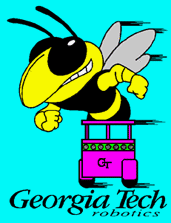
For detailed information on this topic, you can retrieve the following publication:
Motor Schema-based Formation Control for Multiagent Robot Teams
- (119 KB)
Tucker Balch and Ronald C. Arkin.
Formation behaviors developed at Georgia Tech for multi-robot UGV teams will be demonstrated at Demo C. The behaviors are integrated with other navigational behaviors so that robots may carry out general scouting and navigational missions while in formation. Formations are important for a scouting team since they allow the team to utilize its sensor assets more effectively than if the scouts were arranged randomly.
Formations for two, three, and four robot teams, based on existing Army procedures (Field Manual 7-7J), were implemented and tested on MissionLab at Georgia Tech. The line, wedge and column formations for two robots are also running under the DAMN architecure on Martin Marietta's UGVs.
While in formation, each robot is assigned a specific position to maintain relative to the unit-center. The unit-center, which is the average of the robots' positions, is computed several times each second using GPS and communication equipment aboard the UGVs. After the GPS information is received and processed, each robot is able to determine how far out of position it is, and where it ought to move to get back into position.
Control commands which keep the robot in position are separated into fore-aft and side-side corrections. Fore-aft corrections are made by adjusting the robot's speed, while side-side corrections are made by adusting the robot's heading. The size of speed and steering corrections depend on how far out of position the robot is. In general, the further out of position a robot is, the more aggressively it strives to move back into position.
To aid UGV mission planners in selecting appropriate formations for particular situations, we have developed an expert system called the Formation Expert. The Formation Expert automatically analyzes a mission plan (coded in MRPL), then suggests parameter settings for formation behaviors based on that context. A user may then adjust these recommended parameters with a graphical user interface (GUI). The displayed diagram of the formation is adjusted to reflect changes the user makes as he moves slider bars or pushes buttons.
In order to make its recommendations, the Formation Expert consults a rule base, which specifies conditions under which particular formations are appropriate. The rule base is an easy to understand text file that can be revised by a user to reflect new situations or better formations for certain situations. Also, since the Formation Expert is generic it may be easily adapted for use in other UGV domains as well.